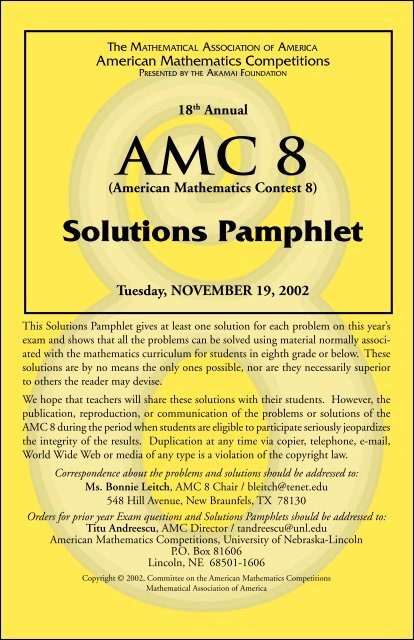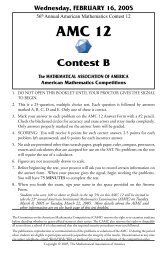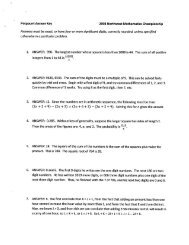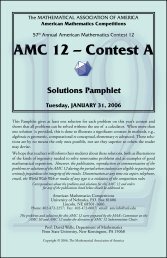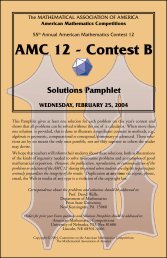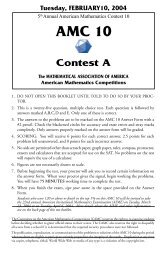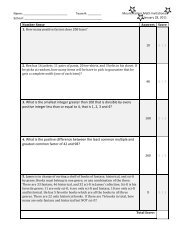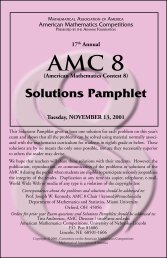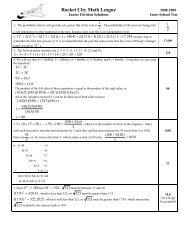Solutions Pamphlet
Solutions Pamphlet
Solutions Pamphlet
- No tags were found...
Create successful ePaper yourself
Turn your PDF publications into a flip-book with our unique Google optimized e-Paper software.
The Mathematical Association of AmericaAmerican Mathematics CompetitionsPresented by the Akamai Foundation18 th AnnualAMC 8(American Mathematics Contest 8)<strong>Solutions</strong> <strong>Pamphlet</strong>Tuesday, NOVEMBER 19, 2002This <strong>Solutions</strong> <strong>Pamphlet</strong> gives at least one solution for each problem on this year’sexam and shows that all the problems can be solved using material normally associatedwith the mathematics curriculum for students in eighth grade or below. Thesesolutions are by no means the only ones possible, nor are they necessarily superiorto others the reader may devise.We hope that teachers will share these solutions with their students. However, thepublication, reproduction, or communication of the problems or solutions of theAMC 8 during the period when students are eligible to participate seriously jeopardizesthe integrity of the results. Duplication at any time via copier, telephone, e-mail,World Wide Web or media of any type is a violation of the copyright law.Correspondence about the problems and solutions should be addressed to:Ms. Bonnie Leitch, AMC 8 Chair / bleitch@tenet.edu548 Hill Avenue, New Braunfels, TX 78130Orders for prior year Exam questions and <strong>Solutions</strong> <strong>Pamphlet</strong>s should be addressed to:Titu Andreescu, AMC Director / tandreescu@unl.eduAmerican Mathematics Competitions, University of Nebraska-LincolnP.O. Box 81606Lincoln, NE 68501-1606Copyright © 2002, Committee on the American Mathematics CompetitionsMathematical Association of America
<strong>Solutions</strong> AMC 8 2002 21. (D) Two distinct lines can intersect in one pointwhereas a line can intersect a circle in two points.The maximum number 5 can be achieved if thelines and circle are arranged as shown. Note thatthe lines could also meet outside the circle for thesame result. (Other arrangements of the linesand circle can produce 0, 1, 2, 3, or 4 points of intersection.)2. (A) Since the total $17 is odd, there must be an odd number of $5 bills. One$5 bill plus six $2 bills is a solution, as is three $5 bills plus one $2 bill. Five$5 bills exceeds $17, so these are the only two combinations that work.3. (C) The smallest average will occur when the numbers are as small as possible.The four smallest distinct positive even integers are 2, 4, 6, and 8 andtheir average is 5.Note: These numbers form an arithmetic sequence. The average of the numbersin any arithmetic sequence is the average of the first and last terms.4. (B) The next palindrome is 2112. The product of its digits is 2 · 1 · 1 · 2 = 4.5. (C) Since 706 days is 700 plus 6 days, it is 100 weeks plus 6 days. Friday is6 days after Saturday.6. (A) Initially, volume increases with time as shown by graphs A, C, and E.But once the birdbath is full, the volume remains constant as the birdbathoverflows. Only graph A shows both features.7. (E) There are 6 + 8 + 4 + 2 + 5 = 25 students. Of the 25 students 5 prefercandy E and 5 25 = 20100 = 20%.8. (D) There are 15 French stamps and 9 Spanish stamps issued in the ‘80s. Sothere are 15 + 9 = 24 European stamps listed in the table in the ‘80s.9. (B) His South American stamps issued before the ‘70s include 4 + 7 = 11from Brazil that cost 11 × $0.06 = $0.66 and 6 + 4 = 10 from Peru that cost10 × $0.04 = $0.40. Their total cost is $0.66 + $0.40 = $1.06.10. (E) The ‘70s stamps cost: Brazil, 12($0.06) = $0.72; Peru, 6($0.04) = $0.24;France, 12($0.06) = $0.72; Spain, 13($0.05) = $0.65. The total is $2.33 forthe 43 stamps and the average price is $2.3343≈ $0.054 ≈ 5.5c|.11. (C) To build the second square from the first, add 3 tiles. To build the thirdfrom the second, add 5 tiles. The pattern of adding an odd number of tilescontinues. For the fourth square, add 7; for the fifth, add 9; for the sixth, add11 and for the seventh, add 13.ORThe number of additional tiles needed is 7 2 − 6 2 = 49 − 36 = 13.
<strong>Solutions</strong> AMC 8 2002 3ORTo build the second square from the first, add 2 + 1 = 3 tiles. To buildthe third from the second, add 3 + 2 = 5 tiles. The pattern continues and7 + 6 = 13.12. (B) Since the sum of the three probabilities is 1, the probability of stoppingon region C is 1 − 1 3 − 1 2 = 6 6 − 2 6 − 3 6 = 1 6 .13. (E) Since the exact dimensions of Bert’s box do notmatter, assume the box is 1×2×3. Its volume is 6. Carrie’sbox is 2 × 4 × 6, so its volume is 48 or 8 times the volumeof Bert’s box. Carrie has approximately 8(125) = 1000jellybeans.Note: Other examples may help to see that the ratio isalways 8 to 1.14. (B) The first discount means that the customer will pay 70% of the originalprice. The second discount means a selling price of 80% of the discountedprice. Because 0.80(0.70) = 0.56 = 56%, the customer pays 56% of theoriginal price and thus receives a 44% discount.15. (E) Areas may be found by dividing each polygon into triangles and squaresas shown.5 55 4 125 12A B C D ENote: Pick’s Theorem may be used to find areas of geoboard polygons. IfI is the number of dots inside the figure, B is the number of dots on theboundary and A is the area, then A = I + B 2− 1. Geoboard figures in thisproblem have no interior points, so the formula simplifies to A = B 2− 1. Forexample, in polygon D the number of boundary points is 11 and 11 2 − 1 = 4 1 2 .
<strong>Solutions</strong> AMC 8 2002 416. (E) The areas are W = 1 2 (3)(4) = 6, X = 1 2 (3)(3) = 4 1 2 , Y = 1 2(4)(4) = 8 andZ = 1 2 (5)(5) = 12 1 2 . Therefore, (E) is correct. X + Y = 4 1 2 + 8 = 12 1 2 = Z.The other choices are incorrect.ORBy the Pythagorean Theorem, if squares are constructed on each side of anyright triangle, the sum of the areas of the squares on the legs equal the areaof the square on the hypotenuse. So 2X + 2Y = 2Z, and X + Y = Z.17. (C) Olivia solved at least 6 correctly to have scored over 25. Her score forsix correct would be 6(+5) + 4(−2) = 22, which is too low. If she answered7 correctly, her score would be 7(+5) + 3(−2) = 29, and this was her score.The correct choice is (C).ORMake a table:Right + score Wrong - score Total9 45 1 −2 438 40 2 −4 367 35 3 −6 29ORIf Olivia answers x problems correctly, then she answered 10 − x incorrectlyand her score was5x − 2(10 − x) = 295x − 20 + 2x = 297x = 49x = 718. (E) In 5 days, Gage skated for 5 × 75 = 375 minutes, and in 3 days he skatedfor 3×90 = 270 minutes. So, in 8 days he skated for 375+270 = 645 minutes.To average 85 minutes per day for 9 days he must skate 9×85 = 765 minutes,so he must skate 765 − 645 = 120 minutes = 2 hours the ninth day.ORFor 5 days Gage skated 10 minutes under his desired average, and for 3 dayshe skated 5 minutes over his desired average. So, on the ninth day he needsto make up 5 × 10 − 3 × 5 = 50 − 15 = 35 minutes. To do this, on the ninthday he must skate for 85 + 35 = 120 minutes = 2 hours.
<strong>Solutions</strong> AMC 8 2002 519. (D) Numbers with exactly one zero have the form 0 or 0, where the blanksare not zeros. There are (9 · 1 · 9) + (9 · 9 · 1) = 81 + 81 = 162 such numbers.20. (D) Segments AD and BE are drawn perpendicular to Y Z. Segments AB,AC and BC divide △XY Z into four congruent triangles. Vertical line segmentsAD, XC and BE divide each of these in half. Three of the eight smalltriangles are shaded, or 3 8 of △XY Z. The shaded area is 3 8(8) = 3.XABYDCEZORSegments AB, AC and BC divide △XY Z into four congruent triangles, sothe area of △XAB is one-fourth the area of △XY Z. That makes the areaof trapezoid ABZY three-fourths the area of △XY Z. The shaded area isone-half the area of trapezoid ABZY , or three-eighths the area of △XY Z,and 3 8(8) = 3.21. (E) There are 16 possible outcomes: HHHH, HHHT , HHT H, HT HH,T HHH, HHT T , HT HT , HT T H, T HT H, T HHT , T T HH and HT T T ,T HT T , T T HT , T T T H, T T T T . The first eleven have at least as many headsas tails. The probability is 1116 .22. (C) When viewed from the top and bottom, there are 4 faces exposed; fromthe left and right sides, there are 4 faces exposed and from the front and back,there are 5 faces exposed. The total is 4 + 4 + 4 + 4 + 5 + 5 = 26 exposedfaces.ORBefore the cubes were glued together, there were 6 × 6 = 36 faces exposed.Five pairs of faces were glued together, so 5 × 2 = 10 faces were no longerexposed. This leaves 36 − 10 = 26 exposed faces.
<strong>Solutions</strong> AMC 8 2002 623. (B) The 6 × 6 square in the upper left-hand region is tessellated, so findingthe proportion of darker tiles in this region will answer the question. The topleft-hand corner of this region is a 3 × 3 square that has 3 + 2 ( 12)= 4 darkertiles. So 4 9of the total area will be made of darker tiles.24. (B) Use 6 pears to make 16 oz of pear juice and 6 oranges to make 24 ozof orange juice for a total of 40 oz of juice. The percent of pear juice is1640 = 4 10 = 40%. ORMiki can make 8 oz of orange juice with 2 oranges, so she can make 4 oz oforange juice with 1 orange. She can make 8 oz of pear juice from 3 pears,so she can make 8 3oz of pear juice from 1 pear. With 1 orange and 1 pear,she can make 4 + 8 3 = 20 3oz of the blend, of which 8 3oz is pear juice. As apercent, = 820 = 410= 40% of the blend is pear juice.8320325. (B) Only the fraction of each friend’s money is important, so we can assumeany convenient amount is given to Ott. Suppose that each friend gave Ott$1. If this is so, then Moe had $5 orignally and now has $4, Loki had $ 4 andnow has $3, and Nick had $3, and now has $2. The four friends now have$4 + $3 + $2 + $3 = $12, so Ott has 312 = 1 4of the group’s money. This samereasoning applies to any amount of money.
TheAmerican Mathematics Contest 8 (AMC 8)Sponsored byThe Mathematical Association of AmericaThe Akamai FoundationUniversity of Nebraska – LincolnContributorsAmerican Mathematical Association of Two Year CollegesAmerican Mathematical SocietyAmerican Society of Pension ActuariesAmerican Statistical AssociationCanada/USA Mathcamp and MathpathCasualty Actuarial SocietyClay Mathematics InstituteConsortium for Mathematics and its ApplicationsInstitute for Operations Research and the Management SciencesKappa Mu EpsilonMu Alpha ThetaNational Association of MathematiciansNational Council of Teachers of MathematicsPi Mu EpsilonSchool Science and Mathematics AssociationSociety of Actuaries


